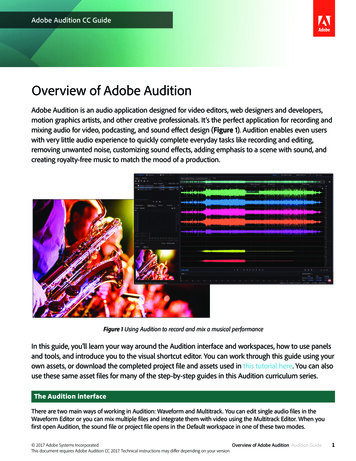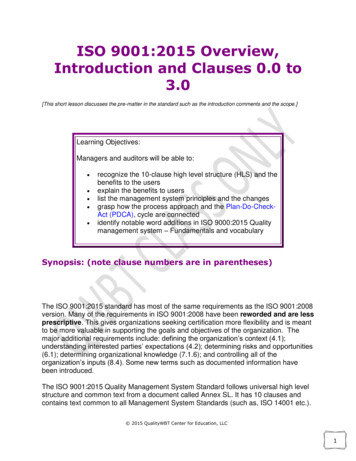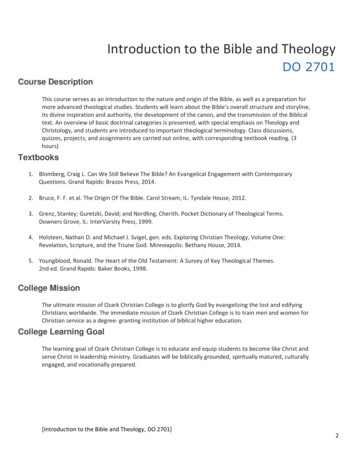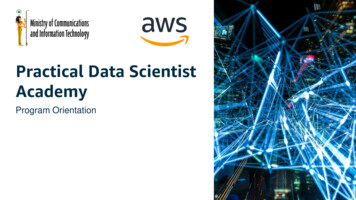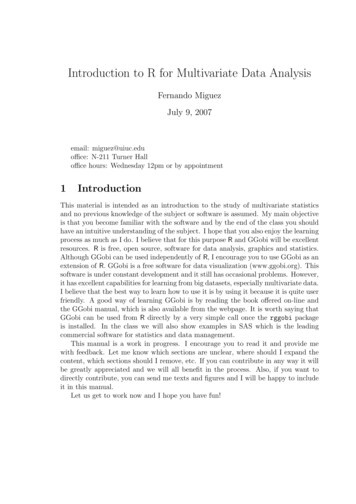
Transcription
Introduction toPodcastingJoshua Stern, PhD
Millions of podcasts are currentlyavailable for free and thousands of newpodcasts are created every day!What’s the big deal about podcasting?Why has it become so popular?Why should you get involved?
What is podcasting?“Pod” – a mobile playback device such as an iPod orany other MP3 player (a laptop or desktop computeralso works).“Casting” – derived from broadcasting.Podcasting is the distribution of multimedia files, suchas audio and video, over the Internet for playback onmobile devices and/or personal computers.Most podcasts are shared (syndicated) using the RSSformat - Real Simple Syndication.
How is a podcast different from aplain old audio file?The key difference is the distribution model.Through RSS, anyone can subscribe to and“catch” podcasts, which will be automaticallydownloaded and managed by a “podcatching”program like iTunes.Simple audio files must be found anddownloaded manually by users.
What kinds of podcasts can I make?Lectures for students to listen to at their leisure.Guest speakers and special events.Student study guides.Supplemental materials for students.Help online students feel more connected.Ideal for Speech, ESL, Foreign Language, Physical Education and many more typesof classes.Have students create their own podcasts as part of your course.Staff development and training.The possibilities are endless!
Why make a podcast?Students like it and are comfortable with the technology.Information comes to the students, they do not have to go get it.Audio and video files can be reused in future courses and also inonline and hybrid courses (ETUDES-NG).Ideal for audio and visual learners – adds variety to yourpresentation strategies.Of great value to students with learning disabilities.Students can review materials/lectures as many times as they want,at their own pace.No more students missing lectures!
What do you need to createaudio podcasts?A personal computer (Mac or PC) connected to theInternet.A microphone (built into new Macs, cheap to buy)or digital recording device.Free podcast-creation software (GarageBand for Macs,Audacity or other for PCs).(You do NOT need an iPod or MP3 player to listen to orcreate podcasts.)
Step 1 – before you beginDecide what you want to record. A live lectureRead from a pre-prepared scriptImprovise from your notes or an outlineDecide on a general format for your recording Intro musicIntroductionSegment 1, 2, 3 Thank you for listeningAdvertise your podcastExit musicCollect image files you want to use to “enhance” youraudio podcast.
Step 2 – live recordingOpen your audio recording program.Select a vocal track, press record, and begin speaking.If you make any mistakes as you speak, just keep going!Mistakes can be cut out during the editing process.Once you’ve finished speaking, don’t forget to pressstop.Save your recording!
Step 3 – editingEdit out any parts of your recording track thatyou do not like.Add sound effects, background music, intro andexit jingles.Add images to correspond to your audio.Save after editing!
Typical GarageBand screenshot
Step 4 – Publishing your podcastSelect a Web server to host your podcast “feed”. You can easily publish directly to iTunes with a .mac account.You can publish to iTunes from a PC as well, but it is more complicated.WLAC plans to support your podcasts, so soon you will not have toworry about this step at all.A “feed” is Web code which communicates the location andsubscription information of your podcast to the world. In other words,your podcast feed is published in RSS format which allows users tosubscribe to it.If you do not care about allowing subscriptions to your podcasts, youcan instead simply upload your audio files to your Website or onlinecourse shell.
iTunes
iTunesFor both Mac and PC users.iTunes is by far the most popular hostingservice, but others are available.It is FREE to upload podcasts (hosting)and download podcasts (subscribing) toyour computer or mobile device.
Where to find (educational) podcastsSearch iTunesEducation Podcast Network- http://www.epnweb.orgPodcast Alley - http://www.podcastalley.comLearning In Hand - ast Directory - http://www.podcastdirectory.comDigg - http://digg.com/podcasts/view/educationOpenCulture - http://www.oculture.com/NPR - http://www.npr.org/rss/podcast/podcast directory.phpLearn Out Loud - http://www.learnoutloud.com/Podcast-DirectoryPod Feed - http://www.podfeed.netOdeo - http://odeo.comThere are many other podcast directories available, just do a searchfor “podcast directory” in your favorite search engine.
Want to lean more?Take part in the WLAC podcasting pilot program.Email me and we can set up a 1-on-1 meeting to helpyou get started designing, creating, and distributing youreducational podcasts.@ONE offers a terrific online course called Podcastingfor Teaching. The instructor led course costs 50; theself-paced version is free. Go to: http://www.cccone.org/There are lots of other free materials to help you get upto speed with podcasting. Just do an Internet search for“podcast basics” or “podcast tutorial.”
THANK YOU!Joshua Sternsternjc@wlac.edu
Step 1 – before you begin Decide what you want to record. A live lecture Read from a pre-prepared script Improvise from your notes or an outline Decide on a general format for your recording Intro music Introduction Segment 1, 2, 3 Thank you for listening Advertise your podcast Exit mu
